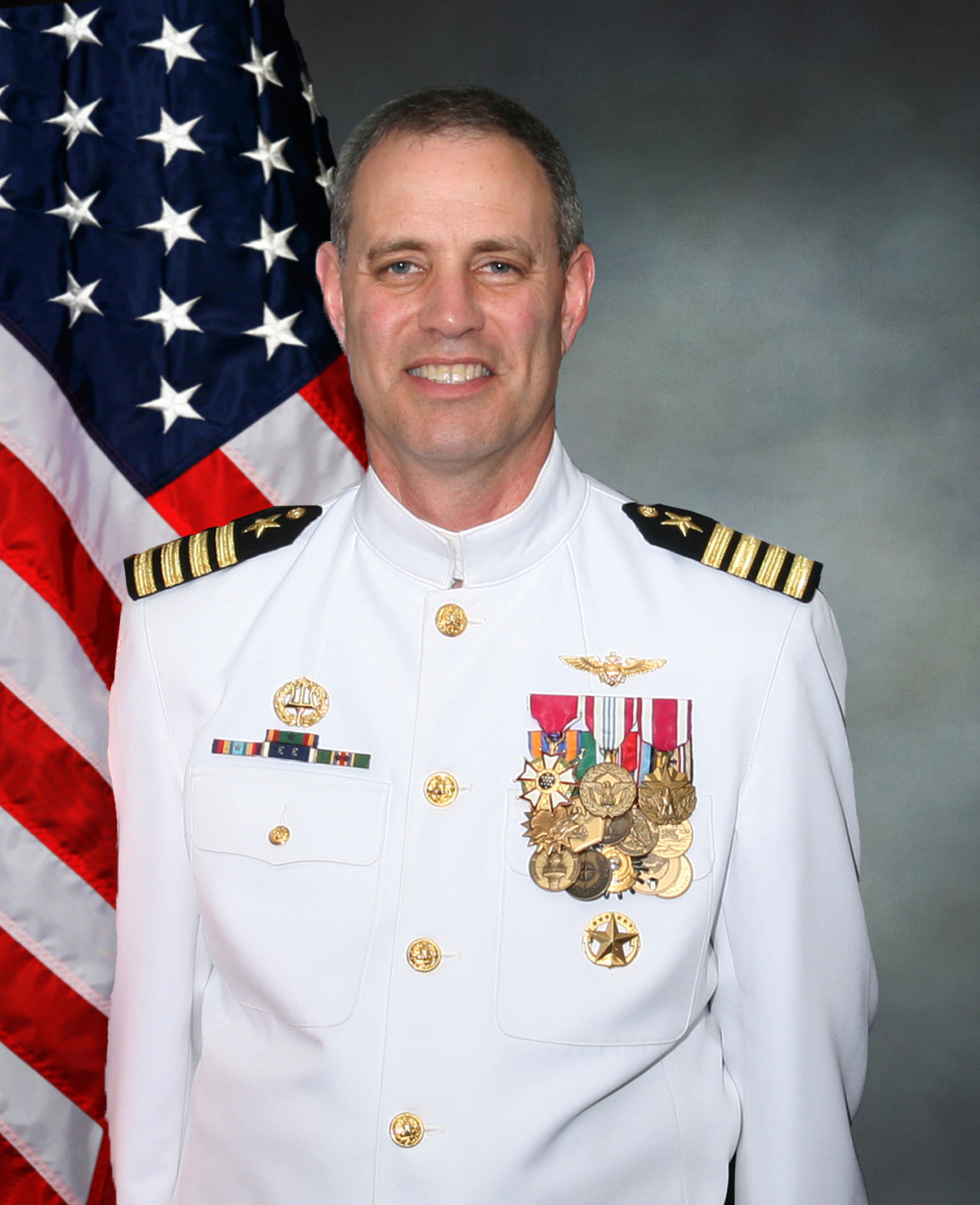F-14 TOMCAT
FIGHTER PILOT
USN



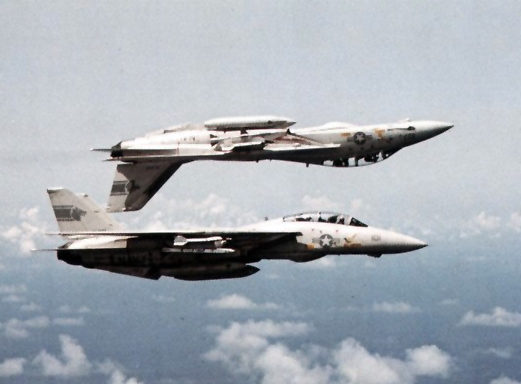
Writing Alex ‘Yogi’ Hnarakis tribute was a kind of weird to me. I knew him well through the English language articles regarding Top Gun and FLIR Integration to the mighty Tomcat but didn’t have the chance to get in touch with him, through letters and emails. His career epitomized the profession (although I prefer the word passion) of a naval aviator. I was determined to contact him and ask him to write me the prologue for our third volume of GREEKS IN FOREIGN COCKPITS, which will be published in 2020 and will feature mostly USN pilots operating from aircraft carriers during WW2. My request was addressed through a common friend and fellow naval aviator David Baranek, and I was waiting for his answer. Unfortunately, he got ill and passed away, so I missed a chance to know a great man. The least I could do was to gather all the information I found from published articles as well as various websites and newspapers in order to present to the Greek people and Greeks worldwide a remarkable aviator. Alexander Hnarakis was of Greek parentage (third generation Greek American) and born in Alexandria Virginia on August 14, 1958. He was the son of Gus Hnarakis, whose father (Alex grandfather), Emanuel Hnarakis, immigrated from the island of Crete to the US, in 1910. His heritage was from Thrapsano, a small village outside Heraklion city. In the United States, he was married to Bessie Vasilakis, who was also from Thrapsano. In fact, the two families had known each other very well. Emanuel and Bessie had 7 children, Gus, Alex’s father, being one of them. Hnarakis family have a great history and many of its members both in Greece and the United States fought during WW2. His grandfather’s brother Gregory Hnarakis fought during the Battle of Crete along with the rest of the Cretan population against the German Elite paratroopers. During the German occupation, he was an active member of the resistance and participated in the kidnapping of Heinrich Kreipe an operation executed jointly by the Special Operations Executive (SOE) and the Cretan resistance, under the leadership of the famous Patrick Leigh Fermor. He also took part in famous raids along with SOE like the sabotage in the German airfield in Kastelli, Crete. Alex’s uncle George was drafted 6 months after he graduated from high school and fought in the Battle of Bulge where he was awarded the Purple Heart. His other uncle, Harry, enlisted in the airforce and his father Gus enlisted in the Navy when the war broke out. With that heritage in his blood, it’s no wonder that Alex was himself also a fighter. Raised in Alexandria, VA, Alex was in the 13th Company at the Naval Academy. He raced USNA sailboats in the Annapolis-Newport, Newport-Bermuda, Marblehead-Halifax and Block Island races. As president of the Sports Parachute Club and USPA jumpmaster, he taught fellow midshipmen skydiving, amassing 210 jumps and competed at the Collegiate Nationals. He graduated from Annapolis with a BS in physics. Post-graduation jumps included the first demonstration jump at the Washington Monument and jumps from the Blue Angels’ Fat Albert for a record all-military freefall formation of 28 jumpers. Alex wanted to fly ever since he was twelve, when in 1968 he sat in front of the TV at his parent’s home in the suburbs of Washington, D.C., and watched the Apollo 8 astronauts flying around the moon. So once out of high school he cut off his long hair, shaved his beard, and entered the U.S. Naval Academy in Annapolis, Maryland. There was a small flying school at a nearby civilian airport, and in his senior year he logged a few solo hours – it wasn’t military flying, of course, more like putt-putting around inside a lawnmower with wings, but it was better than nothing. He graduated in 1978, six months before his flight training was to start, and was put on temporary duty with VF-111 squadron at Miramar, which was just switching from F-4 Phantoms to the awesome F-14 Tomcats. Suddenly he was hanging out with real fighter pilots, sitting in on real briefings, and even hitching rides in the backseat of an A-4 Skyhawk, getting bumped and bounced and breathless pulling G’s. It blew his mind, he remembers, but there was an admission price to this land of the giants.
“I had to do well in flight school, because only by being at the top of the Class could I get my choice of flying fighters, and get to fly F-14s.”
At the height of the Vietnam War, in 1968, the US Navy registered a relatively small 2:1 kill ratio against the North Vietnamese fighters during roughly 360 engagements starting in 1965. Although employing much more sophisticated aerial weaponry against the inferior training of the North Vietnamese pilots who were engaging fiercely with the US Navy in the air to air combat. This awful reality was brought to light by the famous study officially known as The Report of the Air-to-Air Missile System Capability Review which would later go on to be called the Ault Report. The US Navy, according to the report, needed more reliable missiles and adequate training in close-in maneuvering in air combat to give them more advantage in dogfights. Top Gun, which was a nickname for the U.S. Navy Strike Fighter Tactics Instructor (SFTI) program, was first established at the Naval Air Station, Miramar, San Diego, as part of the Fighter Squadron VF-121. It evolved gradually until it ultimately became the premier training program for aerial combat. Alex Hnarakis flew his first deployment with the famous VF-1 Wolfpack when he was chosen, along with his RIO, David ‘Possum’ Cully to attend the Top Gun. The photos above and left, by Charles ‘Heater’ Heatley show Alex flights during his first carrier deployment. The three photos below are from the time when Yogi and Possum flew the Top Gun courses in Miramar. The first two were taken by Tom Kasser showing both above their Tomcat and after a flight in the famous wall of Migs in one of the school’s buildings, showing the graduates Mig kills during the latter stages of Vietnam War. Those photos presented in Ehud Yonay article in California Magazine in May 1983, covering the story of ‘Yogi’ and ‘Possum’ during Top Gun. That article and both the Greek-American pilot and his RIO characters was the reason for the making of the TOP GUN movie some years later. The readers will recognize on ‘Heater’s’ photo the famous inverted flight between ‘Maverick’ F-14 and the enemy ‘Mig-28’. Guess who flew in that picture! You can read more about Alex and Top Gun Movie in the following link: http://www.topgunbio.com/guest-author-yogi-on-top-guns/(Charles ‘Heater’ Heatley, Tom Kasser, US Navy)



The F-14A Bu.No. 161296 was the Tomcat in which Hnarakis flew while attending the TOP GUN class in 1983. A typical Wolfpack Tomcat in the dawn of the low visibility markings era. Hnarakis was a good dogfighter and according to his fellow aviator Mark Wheless: “‘Yogi’ could snap some G’s of the jet, like no other. Τhevy pilots could turn and burn like no other although they had their limitations also: According to former VF-1 pilot, John R. Chesire CDR USNR (Ret.): The troublesome TF-30 fan engine in the early F-14A severely limited it in the dogfight arena. That engine had a tendency to compressor stall at a higher angle of attack. The later F-14D model with vastly improved engines (F110-GE-400) made it a superior dogfighter. However, the F-14 did not fight well when slow. As long as one kept their speed up, the F-14 was a formidable challenge for any other fighter aircraft… despite its large size. However, the F-14A, even with its regrettable early engine did quite well against his USAF opponent new fighter, the Mc. Donnel Douglas F-15 Eagle, in the famous “Dogfight of the Decade” engagement for which you can read on the following link http://flitetime.net/dogfight%20of%20the%20decade.html (Copyright Tom Cooper and Κeith C. Svensen)

Flying during the Top Gun courses is a tough job. Relatively new pilots must fight some of the best pilots Navy has, and some of the best all over the world. Alexander ‘Yogi’ Hnarakis and David ‘Possum’ Cully experiences in the early courses was exactly as Jester told to Maverick in the Top Gun movie: “That was some of the best flying I’ve seen to date — right up to the part where you got killed. However it is better to “die” on training and learn valuable lessons about the art of dogfighting, rather than die in the field of the battle. Alex had the flight and fight abillities, but he should also master them to excellence. And that was exactly what he did learn while attending the Navy Fighters Weapons School. The painting above is a tribute from the GREEKS IN FOREIGN COCKPITS team, to the Greek American pilot, whose story, along with the Top Gun story, through the Ehud Yonay article in California Magazine in 1983, was the reason behind the making the Top Gun movie. Its shows ‘Yogi’ and ‘Possum’ during a BFM engagement with an instructor on his venerable A-4 Skyhawk, over the training ranges in California. Hi-resolution copies will be send to his relatives as well to all those fine gentlemen who helped us understand who Alex really was. The prototype remains in Greece and will be send directly to his family. (Copyright George Moris)
In September 1980 he finished flight school at the top of his class and, with his new gold wings glistening on his tropical khakis, headed for VF-124 squadron at Miramar. Yogi had flown jets in flight school – the T-2 Buckeye and A-4 Skyhawk – but moving up to the F-14 Tomcat meant crossing the magic line that separates the men from the boys. By the fall of 1981 Yogi and Possum had finished their training at VF-124 and were assigned to their permanent squadron, the VF-1 ‘Wolfpack’. And on April 7, 1982, the Wolfpack took off from Miramar and landed aboard the USS Ranger, already underway 100 miles south of San Diego. It would be six months before they’d be back. But then the Ranger reached the Indian Ocean and stayed there for 101 days, and the fun was over. It finally dawned on Yogi that yanking and banking has a deadly intent. One day an order came over the carrier’s speakers, and Yogi and Heater blasted off the deck like human cannonballs, their F-14s loaded to the gills with live ammo. Heading their way was a massive Russian plane that looked like a transport but could have been anything. As they escorted the plane away, Yogi edged up so close that he could look over and see the Russians in their cockpit, staring at him and snapping photographs. He waved the way one does when someone is taking pictures, but the Russians didn’t wave back – not even when Yogi’s backseater took their picture. Yogi and Possum flew at least once a day off the Ranger, but most flights were ordinary patrols or exercises. There was little air combat, except when a few F-14 drivers would head out to a randomly selected “MiG alley” over the ocean and practice dogfighting. Though Yogi would dogfight with the best of them, he was almost too serious for the Wolfpack crowd, and he tried to use those long ocean flights to improve his flying skills. “He was like a sponge, soaking it all in,” says Heater, once an instructor at Top Gun and Yogi’s instructor on the cruise. They spent hours talking tactics in the briefing room before and after missions and in the dining room during meals, and then Heater began teaching Yogi classic air maneuvers such as the “vertical egg,” in which two planes chase each other in ever-widening vertical loops. ln, January they were told to report to Top Gun for air combat training. Now they would learn what being a fighter pilot is really all about. Both Yogi and Possum had a great time and experienced the thrilling experiences training among the best of the best. Their first experiences with their instructor didn’t have a good ending as described in Ehud Yonay article in California Magazine in May 1983:
“Over international waters some 30 miles off Ensenada, a voice crackles over the radio to warn of two bogeys 20 miles south. “Fight’s on,” says Yogi, who is the pilot, or “stick,” and sits up front. “Roger,” says Possum, the radar intercept officer, or “backseater.” He’s already bent over his radarscope, punching buttons and looking for the tiny blips of the bogeys – hotshot instructors from Top Gun, the Navy Fighter Weapons School, flying their deadly little F-5s. With that, Yogi stops jinking, peels off to the right, and pushes the throttle all the way into afterburner. As twin white-hot flames shoot out from the plane’s exhaust nozzles, the magnificent silver machine explodes forward, slamming into their backs like a truckload of bricks and hurling them through the sound barrier. Yogi has rehearsed this kill in his mind a dozen times. He’ll cut the first bogey off at the pass with a head-on missile shot, and then, breaking and rolling to avoid getting hit, he’ll rein the plane in and pull it around like Ivanhoe at the end of the first joust and come racing back across the skies for the other. Great fighter pilots are always ahead of their planes, and, as his adrenaline surges up, Yogi’s eyes bore into the empty blue space before him, looking for the bogeys. Nothing can stop him now. That’s when it happens. Suddenly a soft voice is saying “Atoll” in the earphones, and by the time Possum spots the little F-5 behind them it’s too late. They’ve been racing fat and dumb and happy like a dodo bird, and the F-5 painted in desert camouflage, no less, which stands out against the blue like a billboard – just rolled in out of nowhere, got on their tail, and simulated slipping a heat-seeking missile up their exhaust pipe. Atolls are the air-to-air missiles that Russian-built MiG-21s carry, but in this exercise, the word means, “Up yours, guys, you’re dead and going home with your tail between your afterburners.” Their glorious hop is all screwed up.”
They had to learn the hard way and they did. Yogi and Possum finished the Top Gun course at the end of February 1983. As their class picture went up in the briefing room and they received their new Top Gun flight jacket patches (a MiG caught in a fighter’s crosshairs), the news came that the Wolfpack was named top fighter squadron on the West Coast. Alex skills improved dramatically and one of his fellow aviators Mark Wheless commented that:
“‘Yogi’ could snap some G’s of the jet like no other. My last flight with ‘Yogi’ was 08 Oct 1990. A Good Man.”
For more details regarding Top Gun and Alex, please read the whole Ehud Yonay article in California Magazine, in the excellent website of Dave ‘Bio’ Baranek, in the following links: http://www.topgunbio.com/top-guns-by-ehud-yonay/ and http://www.topgunbio.com/guest-author-yogi-on-top-guns/. It must be noted that Ehud Yonay article was the inspiration behind the Top Gun movie and ‘Yogi’ and ‘Possum’ became an inspiration for ‘Maverick’ and ‘Goose’ characters.
Top: Over the past several years, Alex offered advice and support for the Parachute Team and he will be sorely missed. In the photo below from his USNA days, Alex is in the middle holding the red helmet, with George Argerake to his right and Mike Kennedy to his left. (USNA Parachute Team Alumni & Supporters) Middle: Alex as an LCDR flying with our CO in the back. The aircraft is painted in markings of the Air Wing Commander. This photo was taken during the build-up of forces before the Desert Storm took place. Alex didnt flew operational missions in the Gulf as he was attached to General Horner HQ. (Dave Parsons) Bottom: Gypsy low level. Once we fenced out of Iraq, we were cleared to rage as low and fast as we wanted to as we transited Saudi Arabia en route to the Red Sea where JFK awaited our return. Great way to burn off adrenalin. (Dave Parsons)

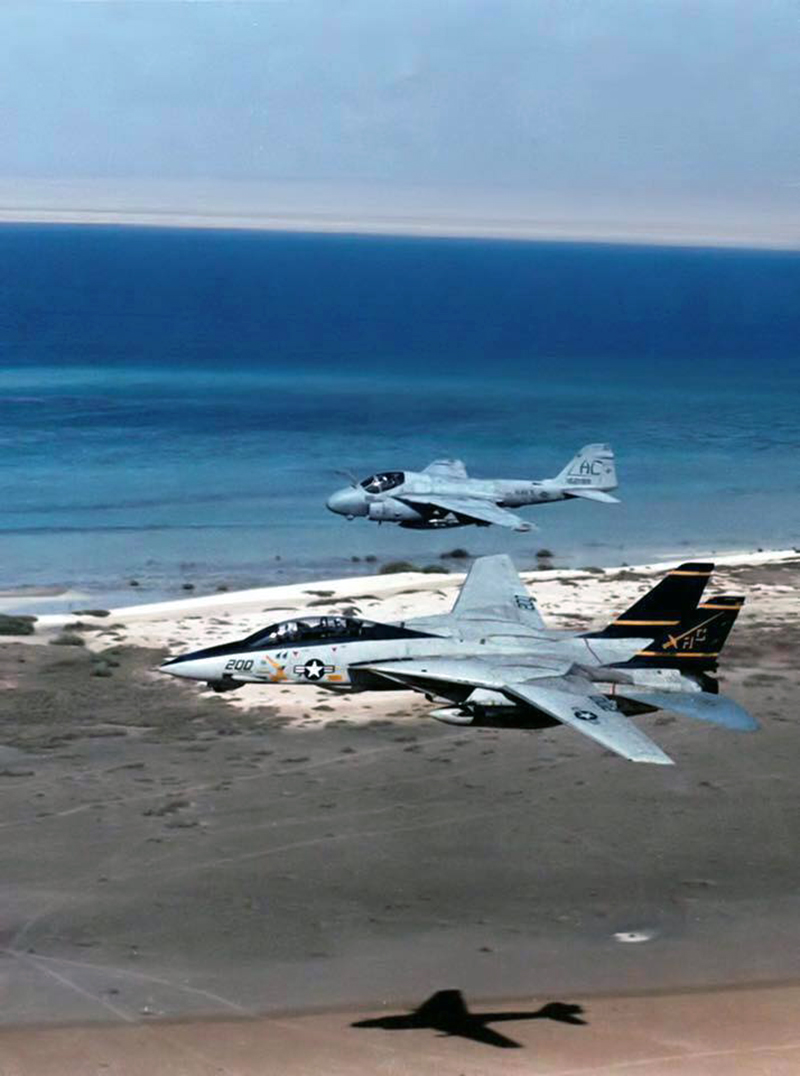



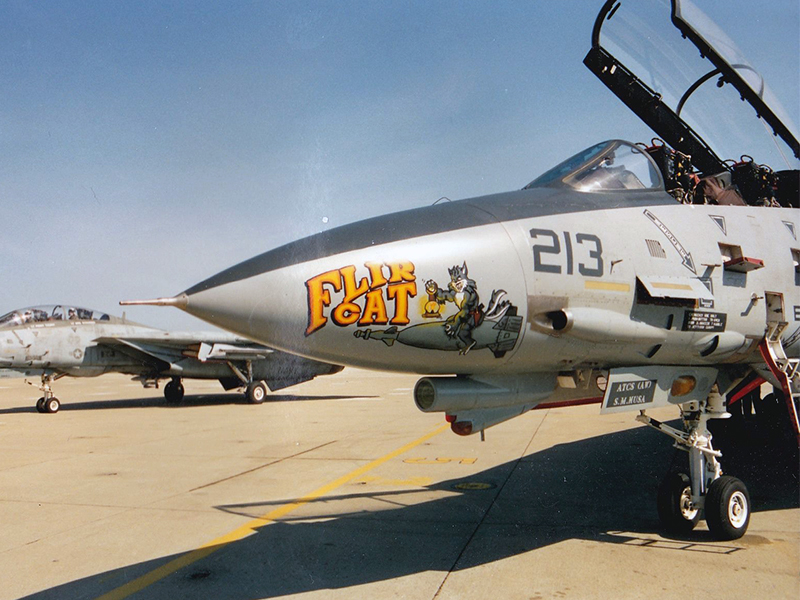

With the impending retirement of the A-6 Intruder and the cancellation of the F-14 Block 1 upgrade package in 1994 due to budgetary restrictions, the Navy found itself with a need for a long-range precision platform. While the Tomcat had always had a latent bombing capability, one which had begun to be explored after Desert Storm, the aircraft was still restricted to delivering unguided bombs or laser-guided bombs designated by another aircraft. It couldn’t self-designate targets, a capability that was growing increasingly crucial in the wake of Desert Storm. Fortunately, Martin Marietta began exploring the feasibility of integrating the AAQ-14 LANTIRN pod, used on the F-15E Strike Eagle and F-16 Fighting Falcon, to enable the Tomcat to fully enter the precision age. Martin split the two-pod LANTIRN system into one, retaining the targeting pod and adding a GPS and inertial measurement unit. This allowed the pod to calculate weapon release parameters on its own, reducing the amount of equipment that needed to be bolted to the jet. In March 1995, F-14Bs from VF-103 Sluggers were the first to drop self-designated laser guided training rounds and laser-guided bombs in testing. By 1996 (after VF-103 had been renamed the Jolly Rogers) the LANTIRN was deployed on a combat cruise for the first time. In commemoration of the first LGB tests, one of VF-103’s Tomcats, Bu.No.161608, AA-213 was nicknamed ‘FLIR Cat’ receiving nose art showing the Tomcat mascot riding a laser-guided bomb while carrying a LANTIRN to signify the Tomcat’s newfound ability to perform precision strikes at night. Coincidentally, the RIO assigned to the aircraft was Larry Slade, who had the misfortune of being shot down in an VF-103 Tomcat in 1991 over Iraq. Except for the profile made for this tribute by Tom Cooper, in the past, aviation artist and author, Lou Drendel immortalized the ‘FlirCat’ and Alex Hnarakis in one of his paintings, which we are happy to have his permission to present here. (Tom Cooper, Lou Drendel, USN, further information by David F. Brown)
Yogi and Possum finished the Top Gun course at the end of February 1983. As their class picture went up in the briefing room and they received their new Top Gun flight jacket patches (a MiG caught in a fighter’s crosshairs), the news came that the Wolfpack was named top fighter squadron on the West Coast-one of only two contenders for the Admiral Clifton Award, the Navy’s greatest tribute to a fighter squadron. Two weeks later the men of the Wolfpack began flying out to land on the pitching and rolling flight deck of the USS Kitty Hawk, some 100 miles out to sea off San Diego, in preparation for their next cruise. This time Yogi and Possum would lead those long fighter patrols over the Indian Ocean, and out there over their wing would be a young pilot just out of training, eager to learn how to be a real fighter pilot. He flew F-14 Tomcats for six deployments in VF-1, VF-32, VF-142, and VF-103. While in VF-32 he participated in the Desert Shield and Desert Storm, but in a more tactical role. According to Dave Parsons:
“Alex was due to leave the squadron in fall of 1990 but when we were emergency deployed to the Red Sea in August, he was put on Operational Hold and used as a liaison to Gen Horner’s staff to coordinate our Air Wing’s participation in the air effort. That meant he flew back and forth to Saudi Arabia on a regular basis. He still flew with VF-32 during that time.”
After leaving the VF-32 he was posted for a brief service to the VF-43 as adversary instructor, flying the A-4 Skyhawk. Again from Dave Parsons recollections:
“Alex went from VF-32 to VF-43 in 1991. My last flight as a Gypsy was in November. Alex was in VF-43 by then and arranged for an impressive sendoff…a literal wall of bogies to greet me after Dog and I exited Dare County bombing target.”
He also served the Pentagon Joint Staff, J-3, Joint Operations Division. Alex was also XO, VF-142 on George Washington (CVN-73), highlighted by hosting WWII veterans on the transatlantic crossing for the D-Day 50th anniversary. Alex was the LANTIRN FLIR & Laser rapid prototype demonstration pilot (while he performed duties of XO for VF-103 named then as ‘Sluggers’), which added precision air-to-ground strike capability to the F-14. Dave Parson told the GIFCs:
“Alex and Rat Slade (who was shot down during the Gulf War and became a POW), were the aircrew who did a proof of concept test flights in 1995. This was very unusual as typically, VX-23 at Pax River would conduct that phase of integration testing. However, there was an effort by Hornet community to stifle any such tests so we appealed to the AIRLANT 3 Star who authorized VF-103 to modify one aircraft as the FLIRCat for testing. The testing was successful and we bypassed the normal DT/OT process and had additional LANTIRN pods available for deployment in the summer of 1996.”
For further details please check ‘Bombcat’ bookazine, an AirForces Monthly 2015 special edition, which documented his squadron’s key contributions, as well as F-14 air-to-ground successes during its final ten years. Alex was CO by then. After the successful test, Alex was also the man who passed the heritage of the famous Jolly Rogers to the VF-103.
“VF-84 was being shut down in 1995 so Wing Commander asked Alex if VF-103 would want to become the Jolly Rogers.” said to us, Dave Parsons
Details about this story can be read in Bio Baranek excellent webpage: http://www.topgunbio.com/snapshot-drills/ in an article written by Hnarakis himself. The Greek parentage Jolly Roger Cmdr led the first LANTIRN and night vision goggle capable Tomcats on deployment aboard Enterprise (CVN-65). In an interview, he gave for a newspaper on Sept. 22, 1996.
“Frankly shooting at anti-air is like shooting at the arrow, not the archer. Command bunkers, air defense operation centers, the places where the people who gather raw information and do the decision-making, you certainly want to be hitting stuff like that.”

The VF-103, F-14B Tomcat, AA201 Bu.No.163224, was Alex ‘Yogi’ Hnarakis fighter during his time as a CO of the famous ‘Jolly Rogers’. Alex took a very active role from the transition of the ‘Sluggers’ to ‘Jolly Rogers’. The Skull and Crossbones first flew in January 1943 on the F4U Corsairs assigned to VF-17, the most lethal Navy fighter squadron of WW II. By the end of the war, the original ‘Jolly Rogers’ had racked up 154.5 kills over the Pacific. Noteworthy the unit’s mascot is a set of skull and crossbones enclosed in a glass encasement that supposedly are the remains of Ens Jack Ernie of VF-17. Ernie died during Okinawa invasion in World War II while fighting against two Japanese Zeroes with his Corsair losing engine oil. Before crashing in his flaming aircraft he made two transmissions; “Skipper, I can’t get out!” followed by a short pause and then, “Remember me with the Jolly Rogers!”. After VF-17 had been decommissioned the Skull and Crossbones insignia adopted by Fighter Squadron 84. After its commissioning in 1955, in an attempt to trace the history of its squadron insignia, the story of Ens. Jack Ernie was revealed to VF-84 by Jack’s family and upon their suggestion and consent, Jack’s skull and femurs were encased in glass and presented to the squadron, thereby fulfilling Jack’s last request of remembering to the Jolly Rogers. To this day, Ens. Jack Ernie is retained on the squadron rooster and his skull and bones go with the Jolly Rogers wherever they go, serving as a symbol of courage and heroism for all Jolly Rogers to follow. According to the site HOME OF M.A.T.S. ‘Passing of the bones’ from the outgoing skipper to the incoming one is a time-honored ‘Jolly Rogers’ tradition. Following VF-84’s decommissioning in October 1995, the decision was made to retire the ‘Club and Cloverleaf’ insignia of the VF-103 ‘Sluggers’ and have Fighting 103 adopt the ‘Jolly Roger’ insignia, on Oct. 1, 1995. Prior to assuming the ‘Jolly Rogers’ name and insignia, VF-103, commissioned in 1952, had consistently proven ready and willing to accomplish all assigned missions while flying successively more complex and more capable aircraft. VF-103 flew numerous sorties in the moonless skies over Vietnam and achieved the only night MiG kill of the entire conflict. (Tom Cooper, USS Enterprise Cruise Book 1996, AA201 Carrier Photo by Javier Rodriguez and AA201 airfield photo by Jan Marie Hanon – further info from https://theaviationgeekclub.com and http://www.f-14association.com)
During an interview aboard Enterprise, for the Defense Daily on April 27, 1996, Cmdr. Alex Hnarakis, CO of VF-103 Tomcat squadron referred to the new capabilities of the mighty Tomcat:
“This will give us the capability to find and destroy targets on our own. That’s value added for the battle group. When it sets out for bombing missions, Tomcats are likely to load up with two 1,000-pound GBU laser-guided bombs or one 2,000-pound GBU. The F-14 has been certified to carry the GBU-16, GBU-10, GBU-12, and is expected to soon receive approval for the GBU-24. The Tomcat has four weapon stations, but typically only two are loaded with bombs. LANTIRN and the night vision goggles “significantly enhance” the ability of the Tomcat to perform forward air control missions. Four of the Tomcat crews in the squadron are qualified to perform forward air control missions. “Now we will be able to do it equally well at night.”
He was later posted to China Lake and became a Navy Test Pilot School graduate and member of the Society of Experimental Test Pilots and later became Commanding Officer of NAWS China Lake. He tested early F/A-18 night vision goggles and the Blue Angels artificial-feel spring. During his time the Naval Air Weapons Station China Lake also conducted several noise-related studies to support the development of the Draft Environmental Impact Statement. These studies characterized the noise effects associated with current and proposed increases to established range flight operations, ordnance use on the China Lake ranges, and flight operations at the Armitage Airfield. These data were also used to support the development of an updated Air Installation Compatible Use Zone plan that addresses noise generated by the airfield operations. Atmospheric conditions like heavy cloud cover over the area will sometimes multiply the effects of noise by focusing or redirecting sound waves back to the ground. Noise is also amplified when it occurs in a valley between two mountain ranges. According to Capt. Alex Hnarakis:
“And what we do here prepares the modern warfighter for success when he or she is asked to go into harm’s way on behalf of their country.”
It must be noted that the Greek American pilot was a candidate for being an astronaut in NASA. He flew 23 aircraft types, he amassed 4,700+ flight hours (3,300+ hours F-14) and had 900+ arrested landings. Awards include the Legion of Merit, Defense Meritorious Service Medal, Meritorious Service Medal, Air Medals with V and Navy Commendation Medals with V. Thankful to those he learned from along the way, Alex especially enjoyed flying sailors or flight test engineers in F-14 or F/A-18 fighters to experience first-hand the fruits of their labor. His Greek name was funny trouble for some of his colleagues and superior officers, according to John T. Nankervis, who flew with him as his RIO:
“I remember flying with Alex in 1987…. after Skipper took a look at the flight schedule board he said, “Skeds, never again put Hnarakis and Nankervis in the same plane. Just too hard to read…..”
Alex Hnarakis passed away May 3, 2018. He always reminded everyone that he lived his dream. ‘Greek in Foreign Cockpits’ team and I (Dimitris Vassilopoulos) personally, will always remember and admire him not only because of our common Greek heritage but for the fact that he was a complete Naval Aviator whose part of his early story immortalized in a way, through the TOP GUN film. I only regret not having the chance to speak and talk with details about our project. That’s why it’s a common decision with Kyriakos Paloulian and George Chalkiadopoulos that our next volume will be devoted to him. Rest in Peace Alexander B. Hnarakis.

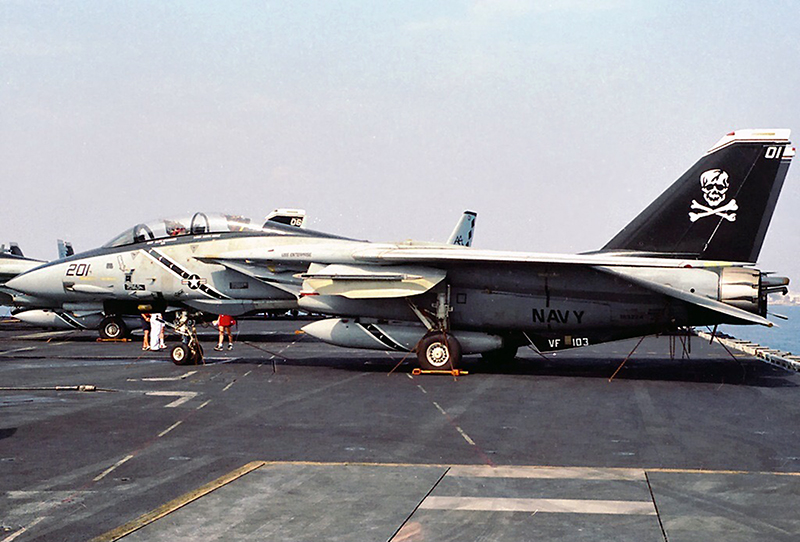


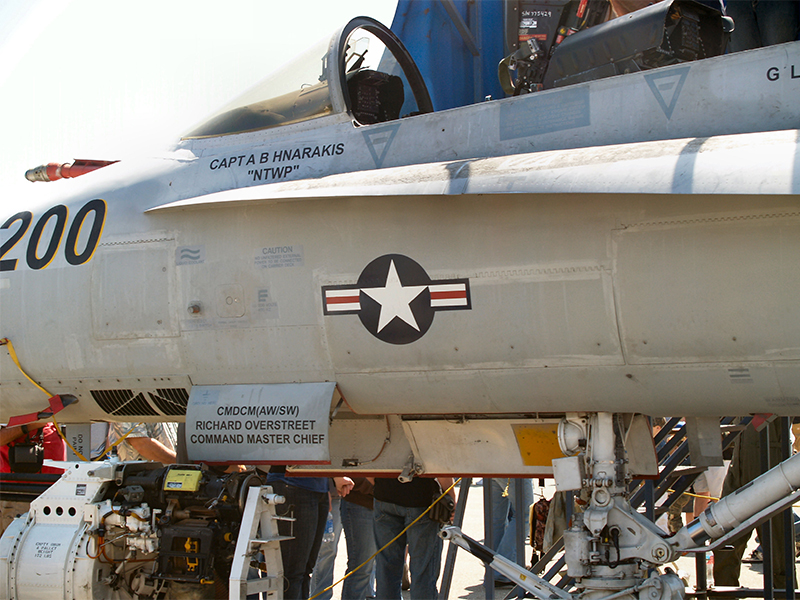

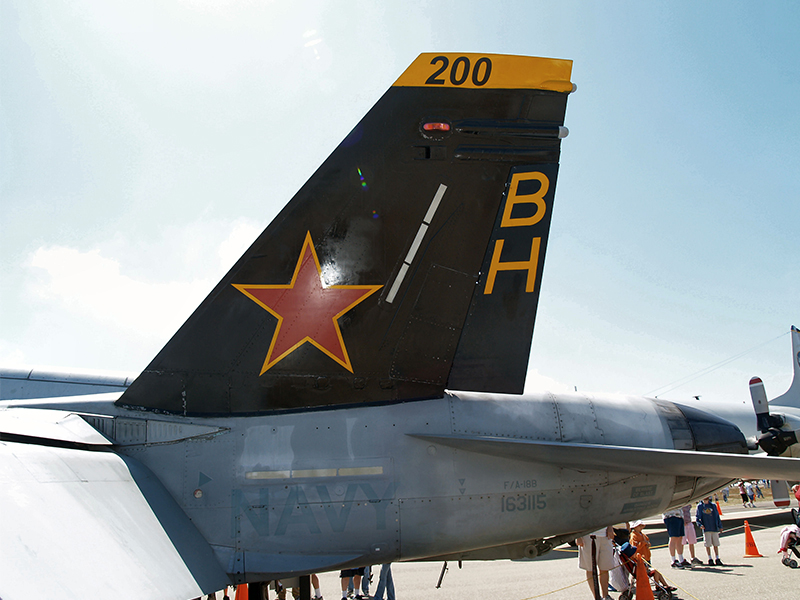
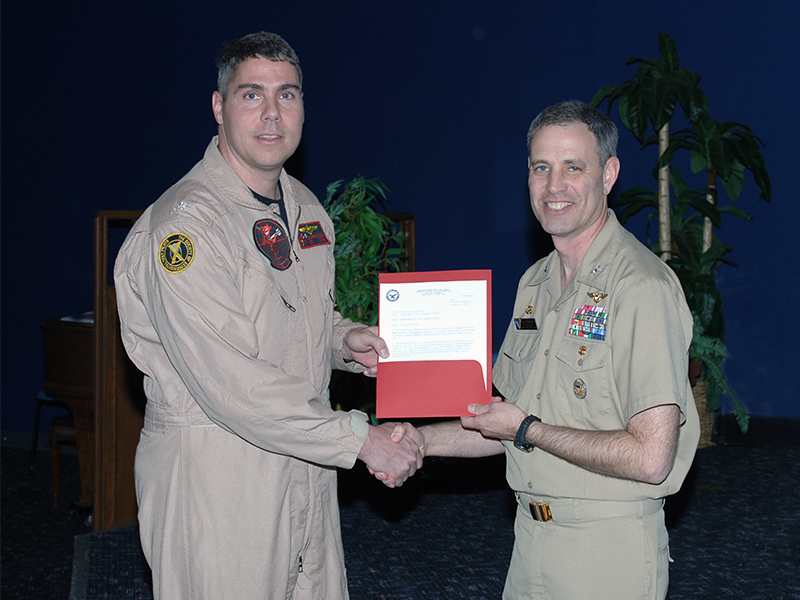
The F/A-18B-20-MC Hornet (Lot 9), BuNo.163115 BH 200 assigned to Capt A B Hnarakis ‘NTWP’ and G L Anema ‘TD’ of VX-30 Bloodhounds. Active in March 2007 coded BH-200 with VX-30 Bloodhounds and in September 2018 coded MA-22 with VMFA-112. Naval Air Station Point Mugu played host to a wide variety of Air Force & USN combat airplanes at the 2007 airshow over the weekend of March 30 – April 1. The photos below left are from that show, courtesy of Goleta Air and Space Museum In the last photo, Alex Hnarakis, CO of NAVAL AIR WEAPONS STATION CHINA LAKE receives the Navy Meritorious Unit Commendation Award on behalf of VX-31. (Tom Cooper, Goleta Air & Space Museum and USN)
FEW WORDS FROM FELLOW NAVAL AVIATORS
AS TOLD TO THE GIFCs TEAM
MARK WHELESS
“I joined the VF-32 Swordsmen on 15 August 1990, the day the USS JOHN F. KENNEDY set sail for what would be known as the first Gulf War. I had returned from my first Mediterranean cruise with my first squadron, the VF-102 Diamondbacks, in late 1989. Leaving my squadron was very unexpected but I was then a bachelor and this was an adventure waiting to happen. We expected to go to war and that was what we were trained to do. Alex “Yogi” Hnarakis was a senior department head in VF-32. Anyone could tell he was an extremely intelligent officer. His opinion on any situation was always sought by higher-ups. I remember him being Skipper’s right-hand man when it came to interpreting information coming down from above, either from the Commander of the Air Group / Wing (CAG) or the Admirals Staff. Yogi was later selected to represent CVW-3 as the airwing planning liaison in Riyadh, Saudi Arabia during Operation Desert Storm. The admiral doesn’t just send anyone to that position during the war. I only flew with Yogi a couple times before he was sent to Riyadh. He was crewed with more junior RIOs in order to get them “up to speed”. Yogi was not a big man as he was average in height but slender in build. I remember that he could, and would, roll the sleeves of his flight suit up over his bicep. I don’t think I ever saw anyone else do that. However, he knew how to fight the F-14 Tomcat. He could apply and maintain maximum g-forces during air combat maneuvering (ACM). He would always know his energy package and he was a master at the dynamic art of ACM. Naval Aviators are judged by how well they perform behind the boat (i.e. land their aircraft on a moving postage stamp). Again, Yogi excelled. He was always known as a safe, conservative stick behind the boat. I was very saddened to hear of Yogi’s passing. We’re losing far too many true warriors before their time. I understand that he fought his illness courageously even taking part in the planning of his treatment. That’s just the way he lived his life. Yogi was truly a great man that served this country well. He will be missed.”
DAVID BARANEK
“I knew Alex “Yogi” Hnarakis from my early years in the F-14 Tomcat community. He was an outstanding combination of a real gentleman and a competitive fighter pilot. Although we were never in the same squadron together, he had a good reputation around NAS Miramar, and that means a lot. Later, we served together on the Joint Staff in the Pentagon, where he continued to prove that he was a professional officer of the highest caliber. I also encountered Alex when he was the commanding officer of VF-103 at NAS Oceana around 1996, where he proved that his combination of intelligence, skill, and leadership ability would bring success to his squadron. With all of these attributes, he remained modest and friendly. He continued to serve the US Navy in several positions of great responsibility, which also demanded his skill as a fighter pilot. I’m telling you, he was a rare and valuable officer. After we both retired I encountered him to work on several projects related to Naval Aviation’s heritage from the 1980s, and it was a joy and privilege to work with him again.”
DAVE PARSONS
“I went to China Lake on business when he was CO of the base. He invited me to his house to eat and go sailing….on land! There was a dry lake across the road from his house and he had a Land Yacht in his carport. His neighbor had one as well so he borrowed that and off we went zipping across the sand in formation. I distinctly remember how patient and instructive he was in teaching me how to master the controls and seek the wind. That was Yogi. We were department heads together in VF-32 ‘89-91 and worked together on many issues. He was always a joy to work with; so personable and knowledgeable. I was heavily involved in getting LANTIRN on the Tomcat so got to interface with him quite a bit when he was XO/CO of VF-103 in 94-96 timeframe. As an avid historian, we talked quite a bit about the heritage of the Jolly Rogers when his squadron was considering taking on in that legacy when VF-84 was “retired”. I always enjoyed catching up with him and we stayed in touch continuously throughout the decades. He was a sterling example of a fine Naval Officer, very talented pilot, and wonderful friend. I’ll always miss him.”
ROBERT MELCHER
“Alex and I met in my plebe year, and he was one year further along at the Academy than I was. I did already have jumping experience from my previous life as an enlisted Marine, but I don’t even remember how we met other than to say Alex and the other senior members of the jump club made me feel right at home. Alex was always careful and very thorough with his responsibilities for us, and also was very active when we communicated with military assets for the rare times we could get reserve pilots training for flight operations. Even then, it was evident Alex wanted to be in the air. I’m not sure which he wanted more: jumping or flying! We had many fun excursions with the team, and when Alex graduated and made air for his service selection, we lost touch for a few years. My last summer at Annapolis I did summer training in San Diego, and lo and behold, Alex was at Miramar training, for Top Gun (like the movie) right next door. Once again we got to visit and catch up on the drop zone, this time at Camp Pendleton. He was a rock star in the air.”

Left: Alex family had a tradition to warfighting. The photo below shows Hnarakis brothers during the WW2 era. According to Alex’s cousin, Christine: “To the left is my father George in an Army uniform, in the middle is my father’s brother Gus in a Navy uniform and my father’s brother Harry in an Airforce uniform. Sitting directly in front of the guys is their mother Bessie. This is a really good picture. You notice Alex went into the Navy just like his dad. George fought in the ETO He was a survivor if the Battle of the Bulge.” (Christine Hnarakis)
Right: The Kreipe abduction team poses before the action: (Rear) Stratis Saviolakis, Manoli Paterakis, Andoni Papaleonidas, Giorgios Tyrakis, Nikos Komis. (Front) Grigori Chnarakis, Patrick Leigh Fermor, William Stanley Moss. Alex’s great uncle was an active member of Greek resistance in Crete and took part in various daring raids, The family bonds with Crete remained strong as Christine wrote us: “I actually met my great uncle Gregory Hnarakis when I came to Greece in 1979. Then I was 23 years old. He invited my older brother, my mother and me for dinner. His daughter cooked the dinner for everyone. I wished I was fluent in Greek to ask him a much of questions. I just smile at him.” (William Stanley Moss)


Left: Two great friends and fellow naval aviators, Dave ‘Bio’ Baranek and Alexander ‘Yogi’ Hnarakis, during a meeting. ‘Bio’ was the man who intruduced our team to Alex and the reason for moving forward this tribute, We are very honored for helping us with this page. (Dave Baranek)
Right: A Tomcat flying in the sunset. The photo was taken by C.J. “Heater” Heatley III, and the F-14 was piloted by none other than the Greek American pilot with Cretan Parentage, Alex Hnarakis. Although the photo was taken during his first deployment it could also symbolize his last flight to heavens…’Yogi’ always like flying and parachuting. RIP. (Charles Heatley)
Thanking’s & Sources
I would like to special thanks to the following men and women. First of all to David Baranek, a man I’m honored to call a friend and who introduced me to Alex’s great career, a well respected Top Gun instructor and author of the famous book Top Gun Days and its prequel, ‘Before Top Gun Days’. Many stories about Alex are on his fabulous website http://www.topgunbio.com/ . In this quest I was lucky to have the guidance of one truly remarkable author and F-14 Pilot, Dave Parsons, author of some of the most known publications regarding the Tomcat, specifically ‘Grumman F-14 Tomcat: Bye – Bye Baby…’, and ‘Fighter Country: The F-14 Tomcats of NAS Oceana’. I also came in contact with Alex’s former instructor in VF-1, Charles ‘Heater’ Heatley who also wrote the magnificent ‘The Cutting Edge’, describing through his photos the deployment of VF-1 aboard USS Ranger. Photos from both Dave and Charles included in Alex tribute. I was also lucky to communicate with Alex’s former RIO while in Top Gun, ‘Possum’ Cully and his fellow USN aviator, Mark Wheeless who kindly provided me with an insight of Alex’s service. I’m also grateful for the help of David Kennedy, editor of the excellent USN magazine ‘Wings of Gold’ for sending me the official portrait of Alex along with his short biography, as it was published in the summer 2018 issue, tributing Hnarakis and USNA Parachute Team Alumni & Supporters. Finally, I was blessed to get in touch with his first cousin, Christine Hnarakis who taught me that behind Alex’s story, lay a proud Greek American family history.
My sincere thanks to Lou Drendel for giving us permission to use his painting of ‘Cloverleaf 213’, George Moris who gives life to everything I’m asking him to draw, for his excellent painting regarding ‘Yogi’ & ‘Possum’ TOP GUN engagement, Javier Rodriguez and Jan Marie Hanon for their pictures and my co-authors in GREEKS IN FOREIGN COCKPITS team, especially Kirk Paloulian for being the first to actually find out about a Tomcat Greek Parentage Pilot some 25 years ago.
Dimitris Vassilopoulos


